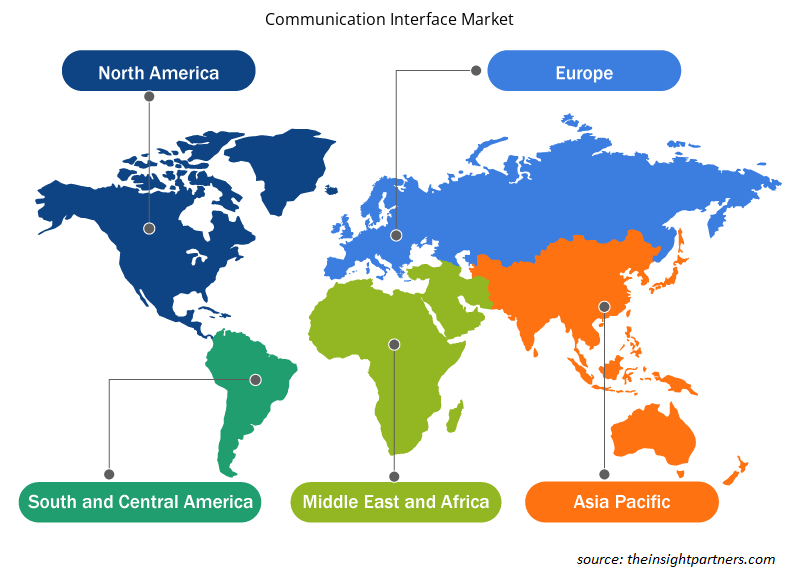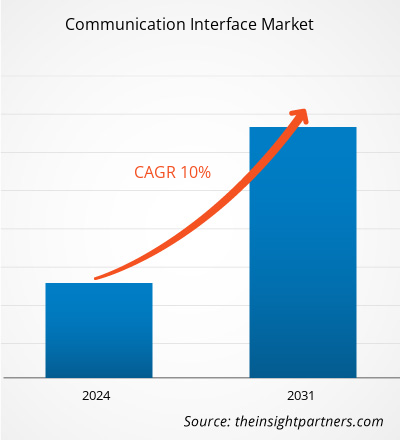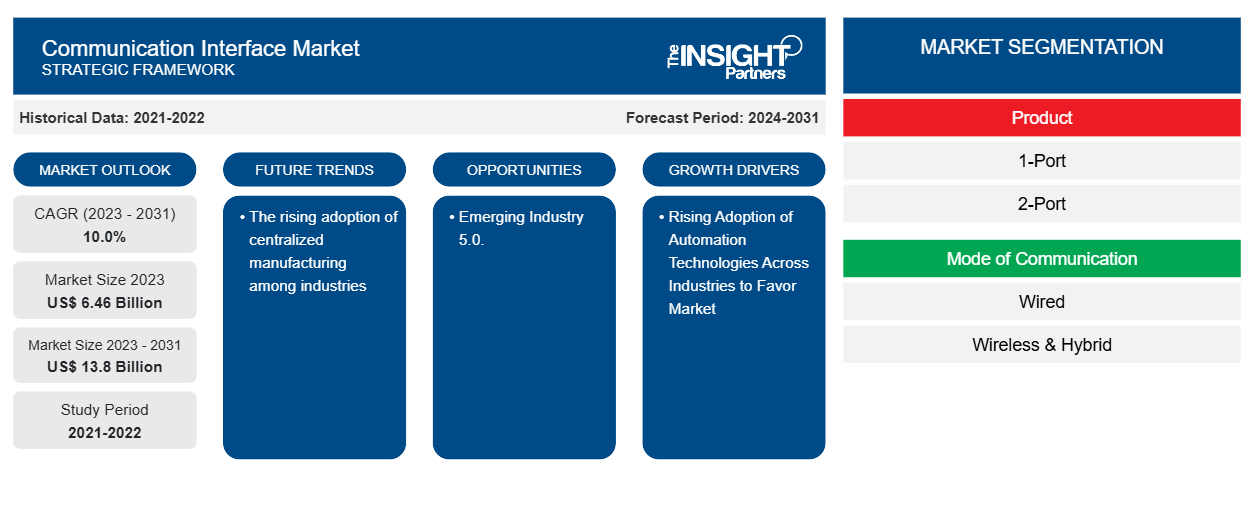Der Markt für Kommunikationsschnittstellen soll von 6,46 Milliarden US-Dollar im Jahr 2023 auf 13,8 Milliarden US-Dollar im Jahr 2031 anwachsen. Der Markt soll zwischen 2023 und 2031 eine durchschnittliche jährliche Wachstumsrate (CAGR) von 10,0 % verzeichnen. Die zunehmende Einführung von Automatisierungstechnologien in allen Branchen und die zunehmende Entwicklung von Robotern dürften die wichtigsten Treiber und Trends des Marktes für Kommunikationsschnittstellen sein.
Marktanalyse für Kommunikationsschnittstellen
Der Markt für Kommunikationsschnittstellen verzeichnet weltweit ein deutliches Wachstum. Dieses Wachstum ist auf die zunehmende Einführung von Automatisierungstechnologien in allen Branchen und die zunehmende Entwicklung von Robotern zurückzuführen. Darüber hinaus wird erwartet, dass die Entstehung von Industrie 5.0 und die zunehmende Einführung zentralisierter Fertigung in den Branchen den Markt in den kommenden Jahren ankurbeln werden.
Marktübersicht für Kommunikationsschnittstellen
Kommunikationsschnittstellen sind Schnittstellen und Protokolle, die die Interaktion von auf einem Computer installierter Software, Betriebssystemen, Verzeichnissen, Netzwerken, Netzwerkbetriebssystemen oder webbasierter Software mit der Microsoft-Plattformsoftware auf einem anderen Computer ermöglichen. Dazu gehören unter anderem Kommunikationsschnittstellen, die der Gewährleistung von Sicherheit, Authentifizierung oder Datenschutz dienen.
Passen Sie diesen Bericht Ihren Anforderungen an
Sie erhalten kostenlose Anpassungen an jedem Bericht, einschließlich Teilen dieses Berichts oder einer Analyse auf Länderebene, eines Excel-Datenpakets sowie tolle Angebote und Rabatte für Start-ups und Universitäten.
-
Holen Sie sich die wichtigsten Markttrends aus diesem Bericht.Dieses KOSTENLOSE Beispiel umfasst eine Datenanalyse von Markttrends bis hin zu Schätzungen und Prognosen.
Treiber und Chancen auf dem Markt für Kommunikationsschnittstellen
Zunehmende Einführung von Automatisierungstechnologien in allen Branchen begünstigt den Markt
Die zunehmende Verbreitung von Automatisierungstechnologien in allen Branchen treibt den Markt für Kommunikationsschnittstellen tatsächlich an. Dies ist auf Faktoren wie die zunehmende Bedeutung der Interkonnektivität zurückzuführen. Es besteht ein hoher Bedarf an nahtloser und bequemer Kommunikation zwischen verschiedenen Systemen und Geräten in der Automatisierung. Die Kommunikationsschnittstelle ermöglicht die Datenübertragung und Kommunikation zwischen Geräten. Zu den gängigen Kommunikationsschnittstellen gehören USB-Schnittstellen, HDMI-Schnittstellen, VGA-Schnittstellen, Ethernet-Schnittstellen, drahtlose Netzwerkschnittstellen usw. Diese Schnittstellen können zum Verbinden von Computern, externen Geräten, Netzwerkgeräten, Monitoren, Druckern usw. verwendet werden, um Datenübertragungs- und Kommunikationsfunktionen zu realisieren. Wenn Branchen ihre Automatisierungsbemühungen skalieren, benötigen sie eine Kommunikationsschnittstelle, die sich leicht an neue Anforderungen und Erweiterungen anpassen lässt.interconnectivity. There is a high need for seamless and convenient communication between various systems and devices in automation. The communication interface enables data transfer and communication between devices. Common communication interfaces include USB interfaces, HDMI interfaces, VGA interfaces, Ethernet interfaces,
Aufkommende Industrie 5.0.
Der Begriff Industrie 5.0 bezieht sich auf die Zusammenarbeit von Menschen mit Robotern und intelligenten Maschinen. Dabei geht es darum, dass Roboter Menschen dabei helfen, besser und schneller zu arbeiten, indem sie fortschrittliche Technologien wie das Internet der Dinge (IoT) und Big Data nutzen. Es fügt den Säulen der Industrie 4.0, Automatisierung und Effizienz, eine persönliche menschliche Note hinzu. Industrie 5.0 ebnet den Weg zum nächsten industriellen Innovationszyklus, der sich an den mit der vierten Iteration kompatiblen Plattformen ausrichtet und die Bedeutung der Zusammenarbeit zwischen Maschine und Mensch, d. h. kollaborative Roboter, berücksichtigt. Kommunikationsnetzwerke spielen eine entscheidende Rolle bei der Aufrechterhaltung der Integration und Hyperkonnektivität zwischen Mensch und Maschine. Mit der Entwicklung von Geräten zu Systemen von Systemen, wie der Integration des Internets der Dinge (IoT) und cyber-physischer Systeme (CPS), haben sich die Eigenschaften von Netzwerken erheblich verändert.IoT) and big data. It adds a personal human touch to the Industry 4.0 pillars of automation and efficiency. Industry 5.0 paves the way to the next industrial innovation cycle that aligns with the platforms compatible with the fourth iteration and addresses the importance of collaboration between machine and man, i.e., collaborative robots. Communication networks play a pivotal role in maintaining the integration and hyperconnectivity between man and machines. With the evolution of devices into systems of systems, such as the integration of the Internet of Things (IoT) and cyber-physical systems (CPS), the characteristics of networks have undergone significant changes.
Segmentierungsanalyse des Marktberichts zur Kommunikationsschnittstelle
Wichtige Segmente, die zur Ableitung der Marktanalyse für Kommunikationsschnittstellen beigetragen haben, sind Produkt, Kommunikationsmodus und Anwendung.
- Basierend auf dem Produkt ist der Markt für Kommunikationsschnittstellen in 1-Port, 2-Port und andere unterteilt. Das 1-Port-Segment wird im Prognosezeitraum voraussichtlich einen erheblichen Marktanteil halten.
- Basierend auf der Art der Kommunikation ist der Markt für Kommunikationsschnittstellen in kabelgebundene (Ethernet, USB, RS-232/RS-485 und andere) und drahtlose und hybride Schnittstellen unterteilt. Das Segment kabelgebundene (Ethernet, USB, RS-232/RS-485 und andere) wird im Prognosezeitraum voraussichtlich einen erheblichen Marktanteil halten.ethernet, USB, RS-232/RS-485, and others) and wireless & hybrid. The wired (ethernet, USB, RS-232/RS-485, and others) segment is anticipated to hold a significant market share in the forecast period.
- Nach Anwendungen ist der Markt in Industrieüberwachung, Batterieüberwachungssysteme, Fernsensorkommunikation, Eisenbahnsignalsysteme, Maschine-zu-Maschine-Kommunikation und andere unterteilt. Die Industrieüberwachung dürfte im Prognosezeitraum einen erheblichen Marktanteil halten.
Marktanteilsanalyse für Kommunikationsschnittstellen nach Geografie
Der geografische Umfang des Marktberichts für Kommunikationsschnittstellen ist hauptsächlich in fünf Regionen unterteilt: Nordamerika, Asien-Pazifik, Europa, Naher Osten und Afrika sowie Süd- und Mittelamerika.
Nordamerika dominiert den Markt für Kommunikationsschnittstellen. Die zunehmende Einführung von Technologien in verschiedenen Branchen in der nordamerikanischen Region hat das Wachstum des Marktes für Kommunikationsschnittstellen vorangetrieben. Faktoren wie die zunehmende Einführung digitaler Tools und hohe Technologieausgaben von Regierungsbehörden dürften das Wachstum des nordamerikanischen Marktes für Kommunikationsschnittstellen vorantreiben. Darüber hinaus zwingt eine starke Betonung von Forschung und Entwicklung in den entwickelten Volkswirtschaften der USA und Kanadas die nordamerikanischen Akteure dazu, technologisch fortschrittliche Lösungen auf den Markt zu bringen. Darüber hinaus gibt es in den USA eine große Anzahl von Akteuren auf dem Markt für Kommunikationsschnittstellen, die sich zunehmend auf die Entwicklung innovativer Lösungen konzentrieren. All diese Faktoren tragen zum Wachstum des Marktes für Kommunikationsschnittstellen in der Region bei.fuelled the growth of the communication interface market. Factors such as increased adoption of digital tools and high technological spending by government agencies are expected to drive the North American communication interface market growth. Moreover, a strong emphasis on research and development in the developed economies of the US and Canada is forcing the North American players to bring technologically advanced solutions into the market. In addition, the US has a large number of communication interface market players who have been increasingly focusing on developing innovative solutions. All these factors contribute to the region's growth of the communication interface market.
Regionale Einblicke in den Markt für Kommunikationsschnittstellen
Die regionalen Trends und Faktoren, die den Markt für Kommunikationsschnittstellen im Prognosezeitraum beeinflussen, wurden von den Analysten von Insight Partners ausführlich erläutert. In diesem Abschnitt werden auch die Marktsegmente und die Geografie von Kommunikationsschnittstellen in Nordamerika, Europa, im asiatisch-pazifischen Raum, im Nahen Osten und Afrika sowie in Süd- und Mittelamerika erörtert.

- Erhalten Sie regionale Daten zum Markt für Kommunikationsschnittstellen
Umfang des Marktberichts zu Kommunikationsschnittstellen
| Berichtsattribut | Details |
|---|---|
| Marktgröße im Jahr 2023 | 6,46 Milliarden US-Dollar |
| Marktgröße bis 2031 | 13,8 Milliarden US-Dollar |
| Globale CAGR (2023 - 2031) | 10,0 % |
| Historische Daten | 2021-2022 |
| Prognosezeitraum | 2024–2031 |
| Abgedeckte Segmente |
Nach Produkt
|
| Abgedeckte Regionen und Länder |
Nordamerika
|
| Marktführer und wichtige Unternehmensprofile |
|
Dichte der Marktteilnehmer für Kommunikationsschnittstellen: Die Auswirkungen auf die Geschäftsdynamik verstehen
Der Markt für Kommunikationsschnittstellen wächst rasant, angetrieben durch die steigende Nachfrage der Endnutzer aufgrund von Faktoren wie sich entwickelnden Verbraucherpräferenzen, technologischen Fortschritten und einem größeren Bewusstsein für die Vorteile des Produkts. Mit steigender Nachfrage erweitern Unternehmen ihr Angebot, entwickeln Innovationen, um die Bedürfnisse der Verbraucher zu erfüllen, und nutzen neue Trends, was das Marktwachstum weiter ankurbelt.
Die Marktteilnehmerdichte bezieht sich auf die Verteilung der Firmen oder Unternehmen, die in einem bestimmten Markt oder einer bestimmten Branche tätig sind. Sie gibt an, wie viele Wettbewerber (Marktteilnehmer) in einem bestimmten Marktraum im Verhältnis zu seiner Größe oder seinem gesamten Marktwert präsent sind.
Die wichtigsten auf dem Markt für Kommunikationsschnittstellen tätigen Unternehmen sind:
- ABB Ltd. Ltd.
- Eaton Corp PlcPlc
- Honeywell International Inc
- Omron Corp
- Rockwell Automation Inc
- Messsysteme; Inc
Haftungsausschluss : Die oben aufgeführten Unternehmen sind nicht in einer bestimmten Reihenfolge aufgeführt.

- Überblick über die wichtigsten Akteure auf dem Markt für Kommunikationsschnittstellen
Nachrichten und aktuelle Entwicklungen zum Markt für Kommunikationsschnittstellen
Der Markt für Kommunikationsschnittstellen wird durch die Erhebung qualitativer und quantitativer Daten nach Primär- und Sekundärforschung bewertet, die wichtige Unternehmenspublikationen, Verbandsdaten und Datenbanken umfasst. Nachfolgend sind einige der Entwicklungen auf dem Markt für Kommunikationsschnittstellen aufgeführt:
- Siemens bringt LOGO! Communication Interface Module auf den Markt. Mit mehreren Kommunikationsprotokollen, Modbus RTU/TCP, App-Integration über RESTful API und der Möglichkeit des Cloud-Zugriffs ist das LOGO! CIM ein echter Game-Changer. Das LOGO! CIM ermöglicht das Senden und Empfangen von SMS sowie die Übertragung von Daten von LOGO! 8.3-Geräten in die AWS Cloud. Mit dem integrierten GNSS-Empfänger (GPS) kann die Position verfolgt und weitergegeben werden. (Quelle: Siemens-Firmenwebsite, Mai 2023)
- Indien hat das Unified Payments Interface (UPI) im historischen Pariser Kaufhaus Galeries Lafayette eingeführt, nach einer erfolgreichen Einführung im ikonischen Eiffelturm. (Pressemitteilung, Juli 2024)
Marktbericht zu Kommunikationsschnittstellen – Umfang und Ergebnisse
Der Bericht „Marktgröße und Prognose für Kommunikationsschnittstellen (2021–2031)“ bietet eine detaillierte Analyse des Marktes, die die folgenden Bereiche abdeckt:
- Marktgröße und Prognose für Kommunikationsschnittstellen auf globaler, regionaler und Länderebene für alle wichtigen Marktsegmente, die im Rahmen des Berichts abgedeckt sind
- Markttrends für Kommunikationsschnittstellen sowie Marktdynamiken wie Treiber, Einschränkungen und wichtige Chancen
- Detaillierte PEST/Porters Five Forces- und SWOT-Analyse
- Marktanalyse für Kommunikationsschnittstellen, die wichtige Markttrends, globale und regionale Rahmenbedingungen, wichtige Akteure, Vorschriften und aktuelle Marktentwicklungen umfasst
- Branchenlandschaft und Wettbewerbsanalyse, einschließlich Marktkonzentration, Heatmap-Analyse, prominenten Akteuren und aktuellen Entwicklungen für den Markt für Kommunikationsschnittstellen.
- Detaillierte Firmenprofile
- Historische Analyse (2 Jahre), Basisjahr, Prognose (7 Jahre) mit CAGR
- PEST- und SWOT-Analyse
- Marktgröße Wert/Volumen – Global, Regional, Land
- Branchen- und Wettbewerbslandschaft
- Excel-Datensatz
Aktuelle Berichte
Erfahrungsberichte
Grund zum Kauf
- Fundierte Entscheidungsfindung
- Marktdynamik verstehen
- Wettbewerbsanalyse
- Kundeneinblicke
- Marktprognosen
- Risikominimierung
- Strategische Planung
- Investitionsbegründung
- Identifizierung neuer Märkte
- Verbesserung von Marketingstrategien
- Steigerung der Betriebseffizienz
- Anpassung an regulatorische Trends























 Kostenlose Probe anfordern für - Markt für Kommunikationsschnittstellen
Kostenlose Probe anfordern für - Markt für Kommunikationsschnittstellen